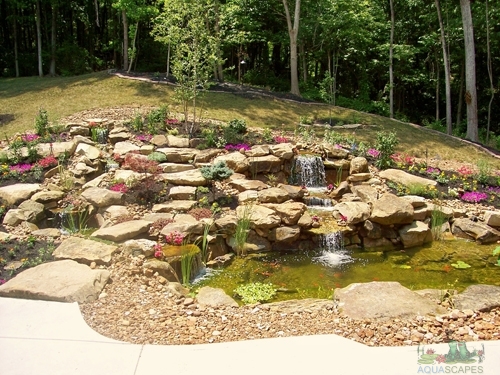[av_textblock fold_type=” fold_height=” fold_more=’Read more’ fold_less=’Read less’ fold_text_style=” fold_btn_align=” textblock_styling_align=” textblock_styling=” textblock_styling_gap=” textblock_styling_mobile=” size=” av-desktop-font-size=” av-medium-font-size=” av-small-font-size=” av-mini-font-size=” font_color=” color=” fold_overlay_color=” fold_text_color=” fold_btn_color=’theme-color’ fold_btn_bg_color=” fold_btn_font_color=” size-btn-text=” av-desktop-font-size-btn-text=” av-medium-font-size-btn-text=” av-small-font-size-btn-text=” av-mini-font-size-btn-text=” fold_timer=” z_index_fold=” id=” custom_class=” template_class=” av_uid=’av-l6qomp92′ sc_version=’1.0′ admin_preview_bg=”]
Vault Depth Guide
This is our Vault Depth Guide. When designing a pond or water garden, one critical aspect to consider is the depth of the water feature. Proper depth is essential for the health of aquatic life, the stability of the ecosystem, and the longevity of the structure. This guide will help you understand the importance of depth, recommended depths for various features, and considerations for your specific needs.
Why Vault Depth Matters
- Temperature Regulation: Deeper water tends to remain cooler in summer and warmer in winter, providing a more stable environment for fish and plants.
- Fish Safety: Adequate depth helps protect fish from predators and extreme temperature fluctuations.
- Ecosystem Balance: Proper depth supports beneficial bacteria and aquatic plants, which contribute to a healthy ecosystem.
- Aesthetic Appeal: The depth of the pond can affect its visual design and how features like fountains or waterfalls integrate into the landscape.
Recommended Vault Depths for Various Water Features
1. Fish Ponds
- Minimum Depth: 3 feet (36 inches)
- Optimal Depth: 4-6 feet (48-72 inches)
- Reasoning: Deeper ponds provide fish with protection from temperature extremes and predators. A depth of at least 3 feet is essential for fish to survive winter freezes.
2. Water Gardens
- Minimum Depth: 1-2 feet (12-24 inches)
- Optimal Depth: 2-3 feet (24-36 inches)
- Reasoning: Water gardens can support various aquatic plants and small fish. Shallow areas promote plant growth, while deeper sections help maintain water quality.
3. Koi Ponds
- Minimum Depth: 4 feet (48 inches)
- Optimal Depth: 5-7 feet (60-84 inches)
- Reasoning: Koi are larger fish that require deeper ponds for safety and comfort. Depth also helps prevent overheating and provides space for them to thrive.
4. Natural Swimming Ponds
- Minimum Depth: 3-4 feet (36-48 inches)
- Optimal Depth: 5-8 feet (60-96 inches)
- Reasoning: Depth helps maintain water temperature and clarity, while also allowing for the necessary filtration and regeneration zones.
5. Fountains and Waterfalls
- Minimum Depth: 18 inches (1.5 feet)
- Optimal Depth: 2-3 feet (24-36 inches)
- Reasoning: Fountains need sufficient depth to accommodate pumps and ensure proper water flow. Deeper pools help with water circulation and aesthetic appeal.
Additional Vault Depth Considerations
- Climate Zone: Consider your local climate when determining depth. In colder areas, deeper ponds may be necessary to prevent freezing.
- Type of Fish and Plants: Research the specific requirements of the fish and plants you intend to keep, as different species may require varying depths for optimal health.
- Water Quality Management: Regularly monitor water quality parameters, as depth can influence factors like temperature stratification, oxygen levels, and nutrient distribution.
- Design Aesthetics: Think about the overall design of your water feature. Varying depths can create visual interest and enhance the beauty of the pond or water garden.
- Safety Precautions: If your water feature will be accessible to pets or children, consider adding safety measures, such as shallow edges or barriers.
Understanding the importance of depth in your pond or water garden is crucial for creating a thriving aquatic ecosystem. By following the recommended depths for various water features and considering your specific needs, you can design a beautiful and functional water feature that enhances your landscape. Proper depth will ensure the health and longevity of your aquatic life, while also providing you with a serene outdoor space to enjoy. Happy pond keeping!
[/av_textblock]
[av_image src=’https://aquascapes.com/wp-content/uploads/2014/02/Fry-2015-1-scaled.jpg’ attachment=’6465′ attachment_size=’full’ src_dynamic=” copyright=” caption=” image_size=” styling=” box_shadow=’none’ box_shadow_width=’10’ box_shadow_color=” align=’center’ font_size=” overlay_opacity=’0.4′ overlay_color=’#000000′ overlay_text_color=’#ffffff’ link=” link_dynamic=” target=” animation=’no-animation’ animation_duration=” animation_custom_bg_color=” animation_z_index_curtain=’100′ parallax_parallax=” parallax_parallax_speed=” av-desktop-parallax_parallax=” av-desktop-parallax_parallax_speed=” av-medium-parallax_parallax=” av-medium-parallax_parallax_speed=” av-small-parallax_parallax=” av-small-parallax_parallax_speed=” av-mini-parallax_parallax=” av-mini-parallax_parallax_speed=” hover=” blur_image=” grayscale_image=” fade_image=” appearance=” css_position=” css_position_location=’,,,’ css_position_z_index=” av-desktop-css_position=” av-desktop-css_position_location=’,,,’ av-desktop-css_position_z_index=” av-medium-css_position=” av-medium-css_position_location=’,,,’ av-medium-css_position_z_index=” av-small-css_position=” av-small-css_position_location=’,,,’ av-small-css_position_z_index=” av-mini-css_position=” av-mini-css_position_location=’,,,’ av-mini-css_position_z_index=” transform_perspective=” transform_rotation=’,,,’ transform_scale=’,,’ transform_skew=’,’ transform_translate=’,,’ av-desktop-transform_perspective=” av-desktop-transform_rotation=’,,,’ av-desktop-transform_scale=’,,’ av-desktop-transform_skew=’,’ av-desktop-transform_translate=’,,’ av-medium-transform_perspective=” av-medium-transform_rotation=’,,,’ av-medium-transform_scale=’,,’ av-medium-transform_skew=’,’ av-medium-transform_translate=’,,’ av-small-transform_perspective=” av-small-transform_rotation=’,,,’ av-small-transform_scale=’,,’ av-small-transform_skew=’,’ av-small-transform_translate=’,,’ av-mini-transform_perspective=” av-mini-transform_rotation=’,,,’ av-mini-transform_scale=’,,’ av-mini-transform_skew=’,’ av-mini-transform_translate=’,,’ mask_overlay=” mask_overlay_shape=’blob’ mask_overlay_size=’contain’ mask_overlay_scale=’100%’ mask_overlay_position=’center center’ mask_overlay_repeat=’no-repeat’ mask_overlay_rotate=” mask_overlay_rad_shape=’circle’ mask_overlay_rad_position=’center center’ mask_overlay_opacity1=’0′ mask_overlay_opacity2=’1′ mask_overlay_opacity3=” title_attr=” alt_attr=” img_scrset=” lazy_loading=’disabled’ id=” custom_class=” template_class=” av_element_hidden_in_editor=’0′ av_uid=’av-m27zssxs’ sc_version=’1.0′ admin_preview_bg=”][/av_image]
[av_one_full first min_height=” vertical_alignment=” space=” custom_margin=” margin=’0px’ link=” linktarget=” link_hover=” padding=’0px’ border=” border_color=” radius=’0px’ background=’bg_color’ background_color=” background_gradient_color1=” background_gradient_color2=” background_gradient_direction=’vertical’ src=” background_position=’top left’ background_repeat=’no-repeat’ animation=” mobile_breaking=” mobile_display=” av_uid=’av-10y8z8n’]
[av_textblock fold_type=” fold_height=” fold_more=’Read more’ fold_less=’Read less’ fold_text_style=” fold_btn_align=” textblock_styling_align=” textblock_styling=” textblock_styling_gap=” textblock_styling_mobile=” size=” av-desktop-font-size=” av-medium-font-size=” av-small-font-size=” av-mini-font-size=” font_color=” color=” fold_overlay_color=” fold_text_color=” fold_btn_color=’theme-color’ fold_btn_bg_color=” fold_btn_font_color=” size-btn-text=” av-desktop-font-size-btn-text=” av-medium-font-size-btn-text=” av-small-font-size-btn-text=” av-mini-font-size-btn-text=” fold_timer=” z_index_fold=” id=” custom_class=” template_class=” av_uid=’av-108iu6v’ sc_version=’1.0′ admin_preview_bg=”]
Check out our store for all your water gardening needs! Aquascape products are Aquascape Inc. Certified.
Thanks for reading at Meyer Aquascapes! We hope you’ve enjoyed our Vault Depth Guide. Please leave a comment below if you liked it or have any questions. We’d love to hear from you! Thanks for stopping by!
[/av_textblock]
[/av_one_full][av_hr class=’short’ height=’50’ shadow=’no-shadow’ position=’center’ custom_border=’av-border-thin’ custom_width=’50px’ custom_border_color=” custom_margin_top=’30px’ custom_margin_bottom=’30px’ icon_select=’yes’ custom_icon_color=” icon=’ue808′ font=’entypo-fontello’ av_uid=’av-4bnqpz’ admin_preview_bg=”]
[av_heading heading=’How can we help?’ tag=’h1′ link_apply=” link=” link_target=” style=’blockquote modern-quote modern-centered’ size=” subheading_active=” subheading_size=’15’ margin=” padding=’10’ color=” custom_font=” custom_class=” admin_preview_bg=” av-desktop-hide=” av-medium-hide=” av-small-hide=” av-mini-hide=” av-medium-font-size-title=” av-small-font-size-title=” av-mini-font-size-title=” av-medium-font-size=” av-small-font-size=” av-mini-font-size=”][/av_heading]
[av_textblock size=” font_color=” color=” av-desktop-hide=” av-medium-hide=” av-small-hide=” av-mini-hide=” av-medium-font-size=” av-small-font-size=” av-mini-font-size=” av_uid=’av-334avi’]
[/av_textblock]

